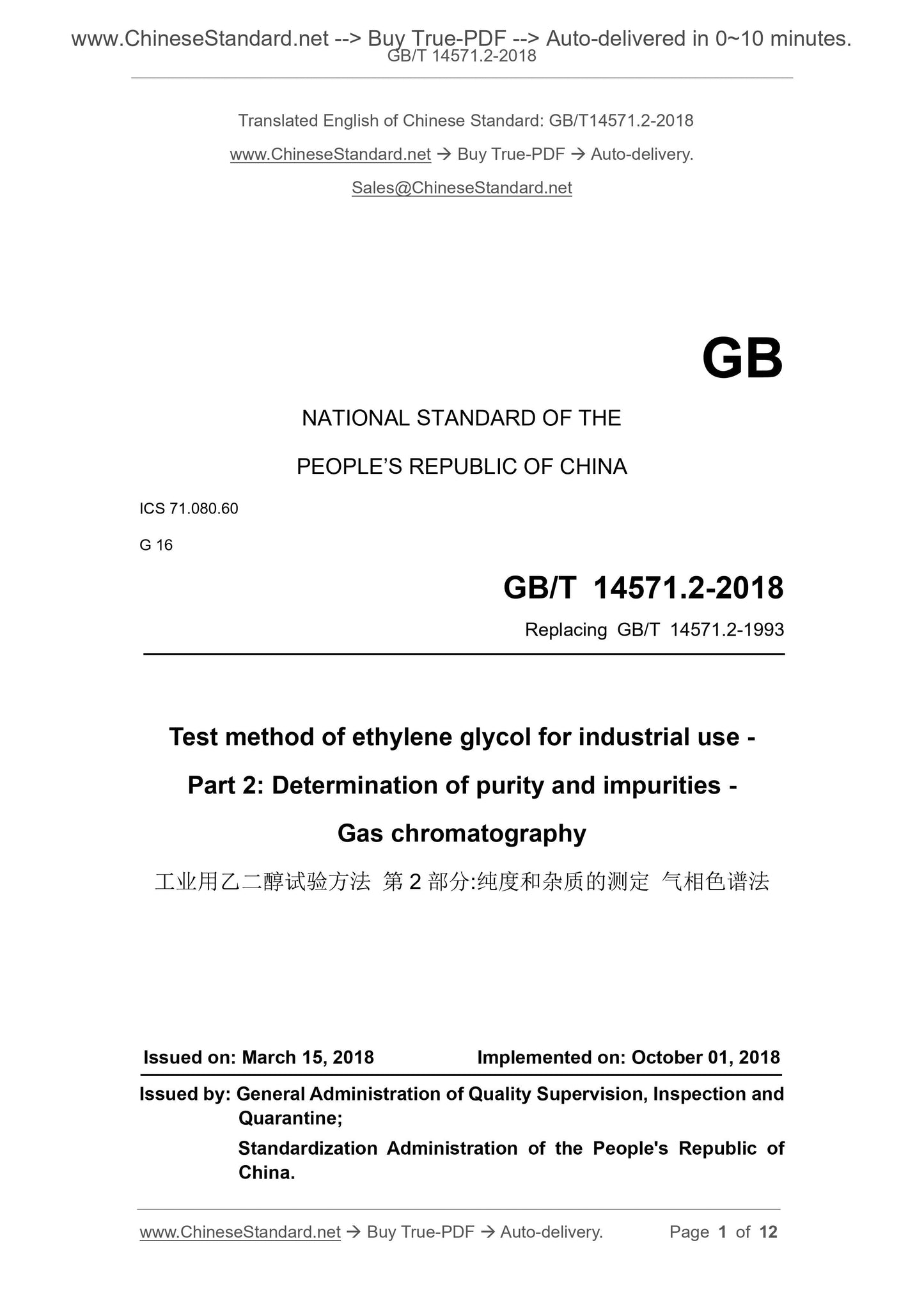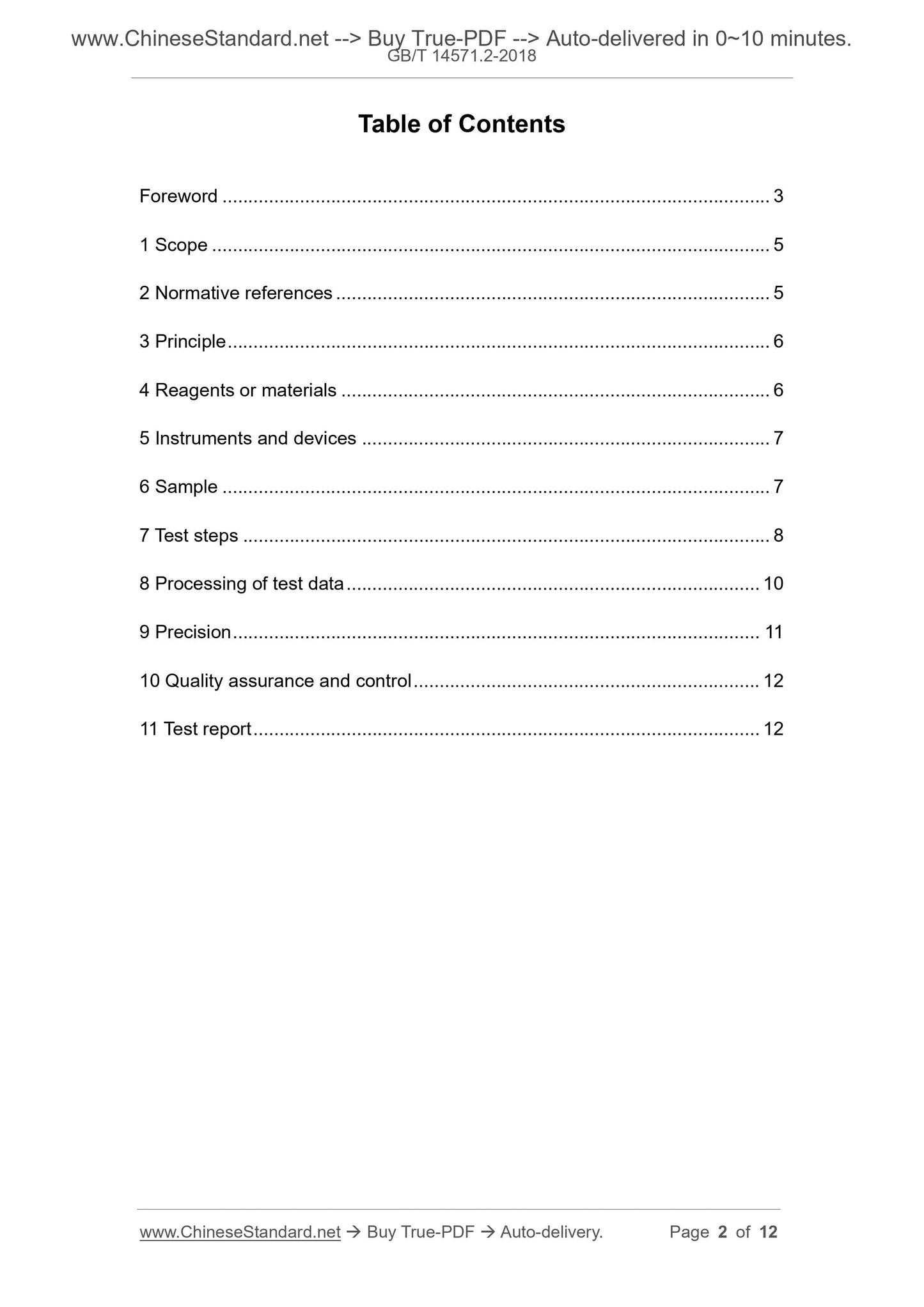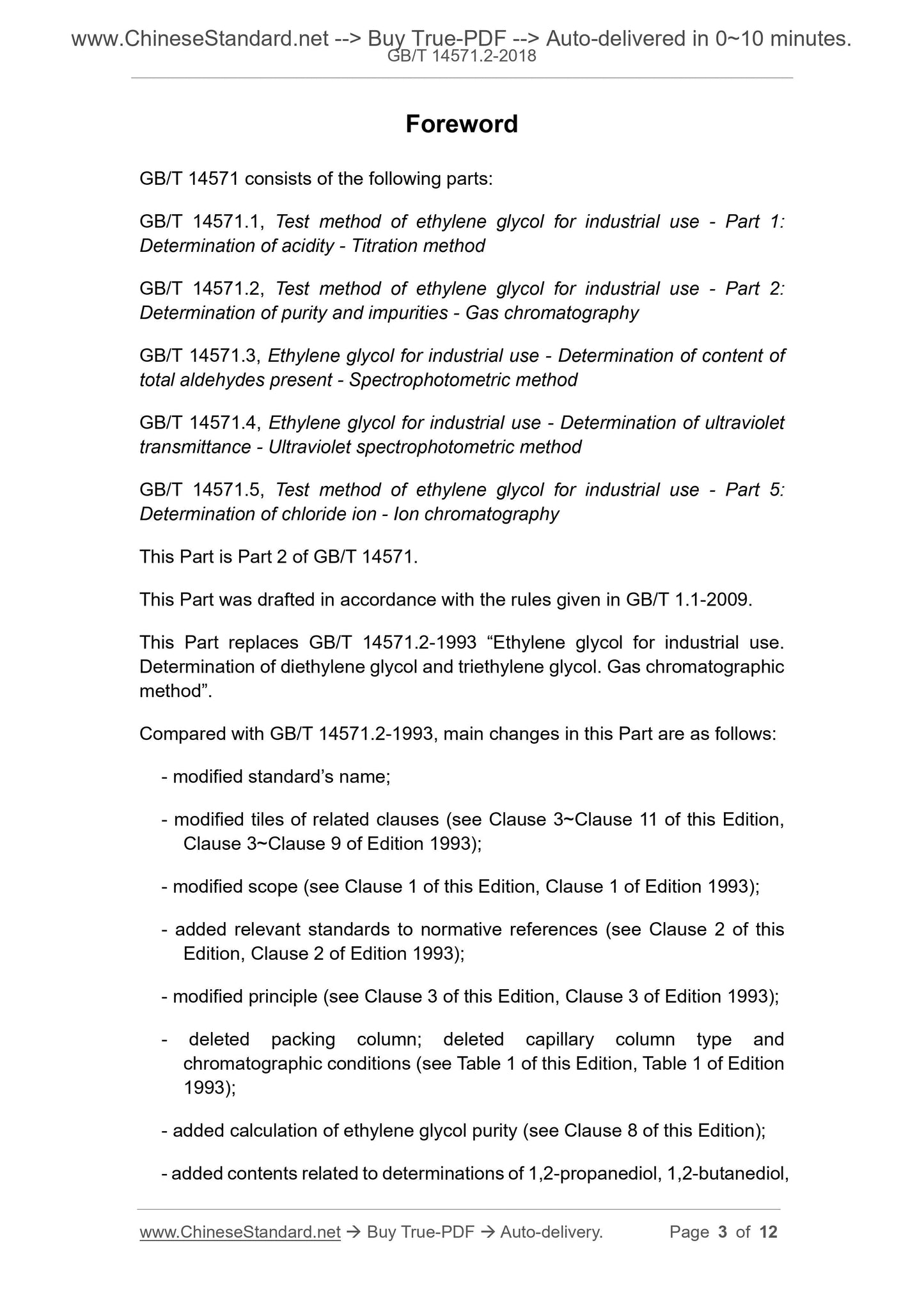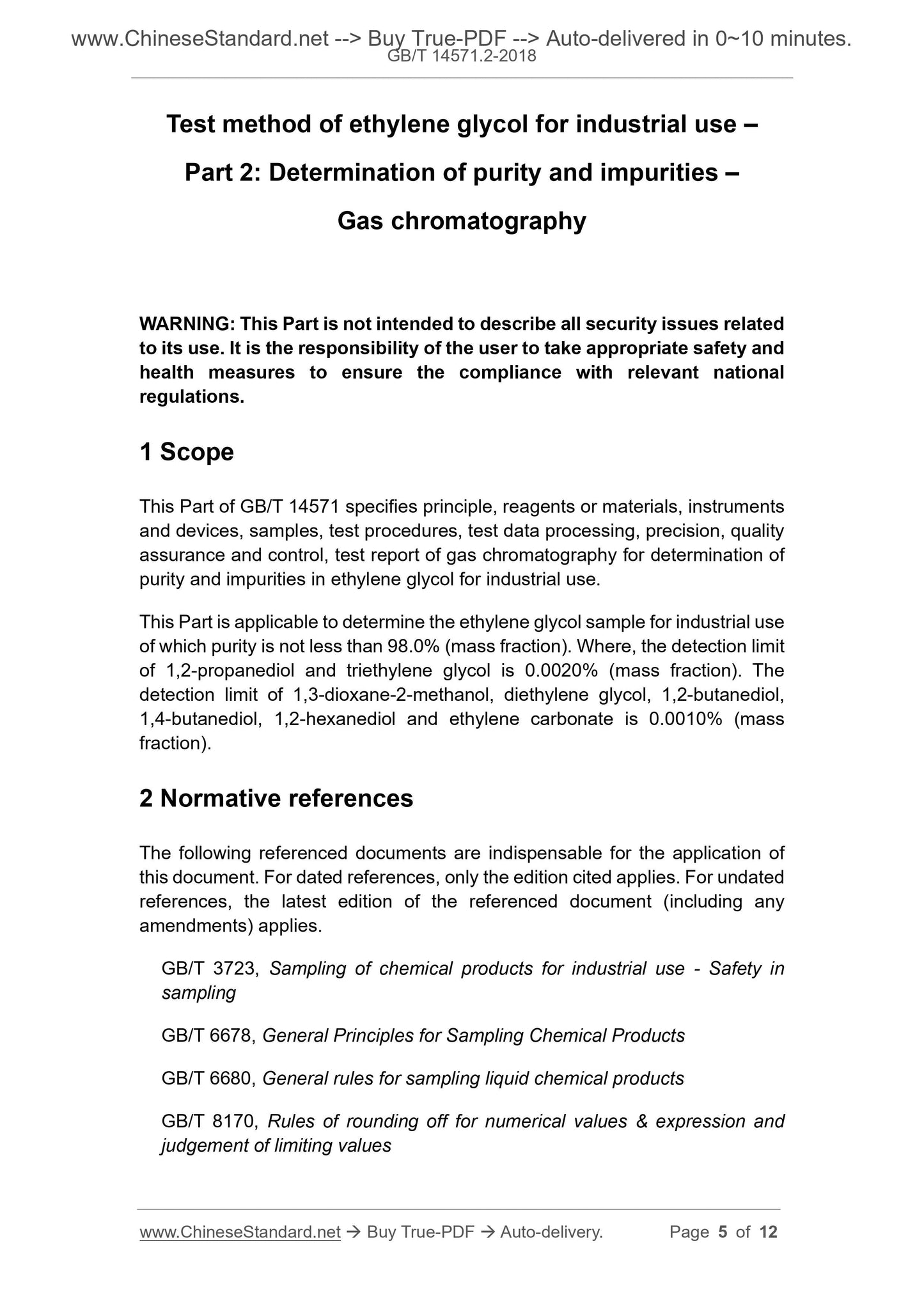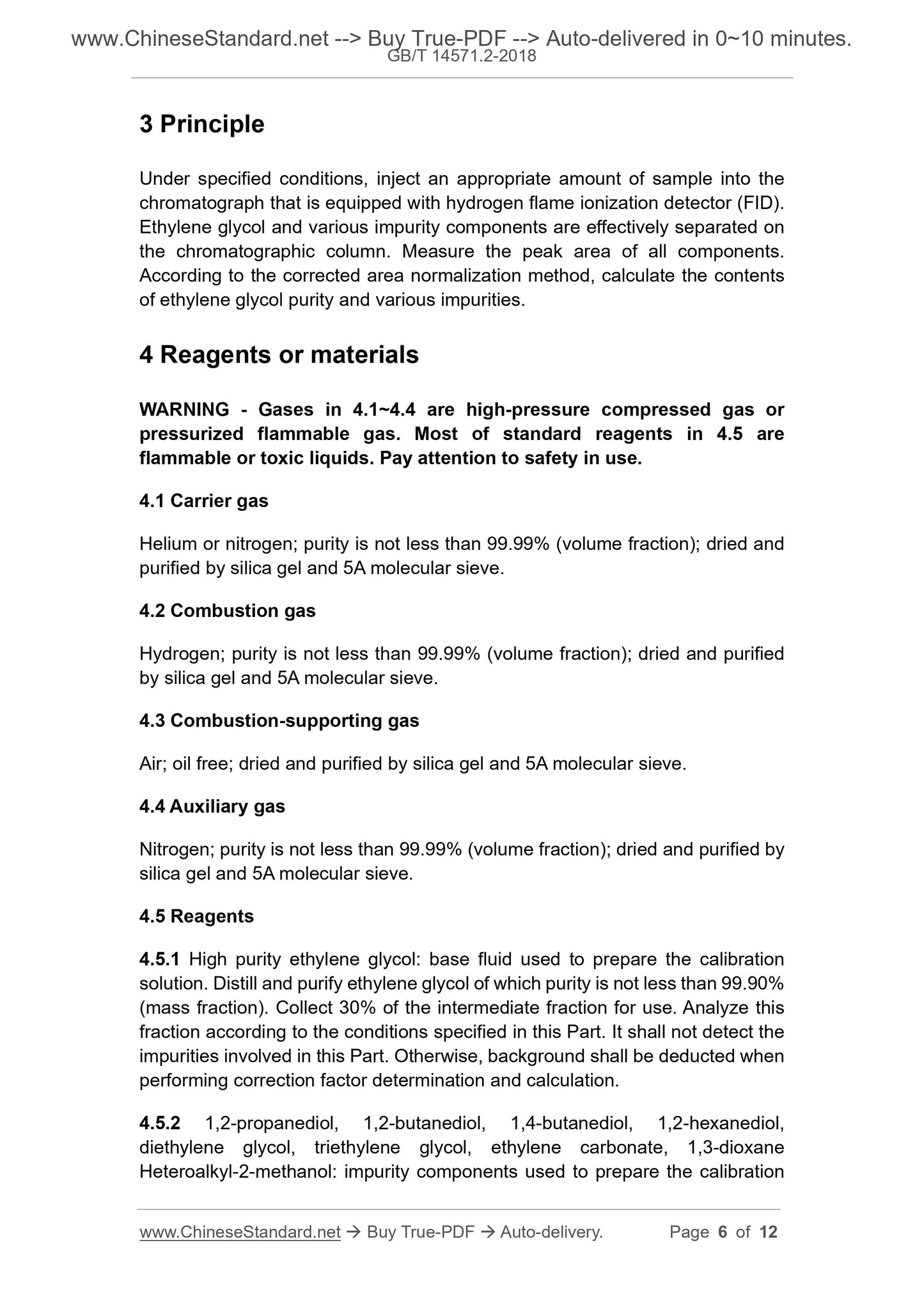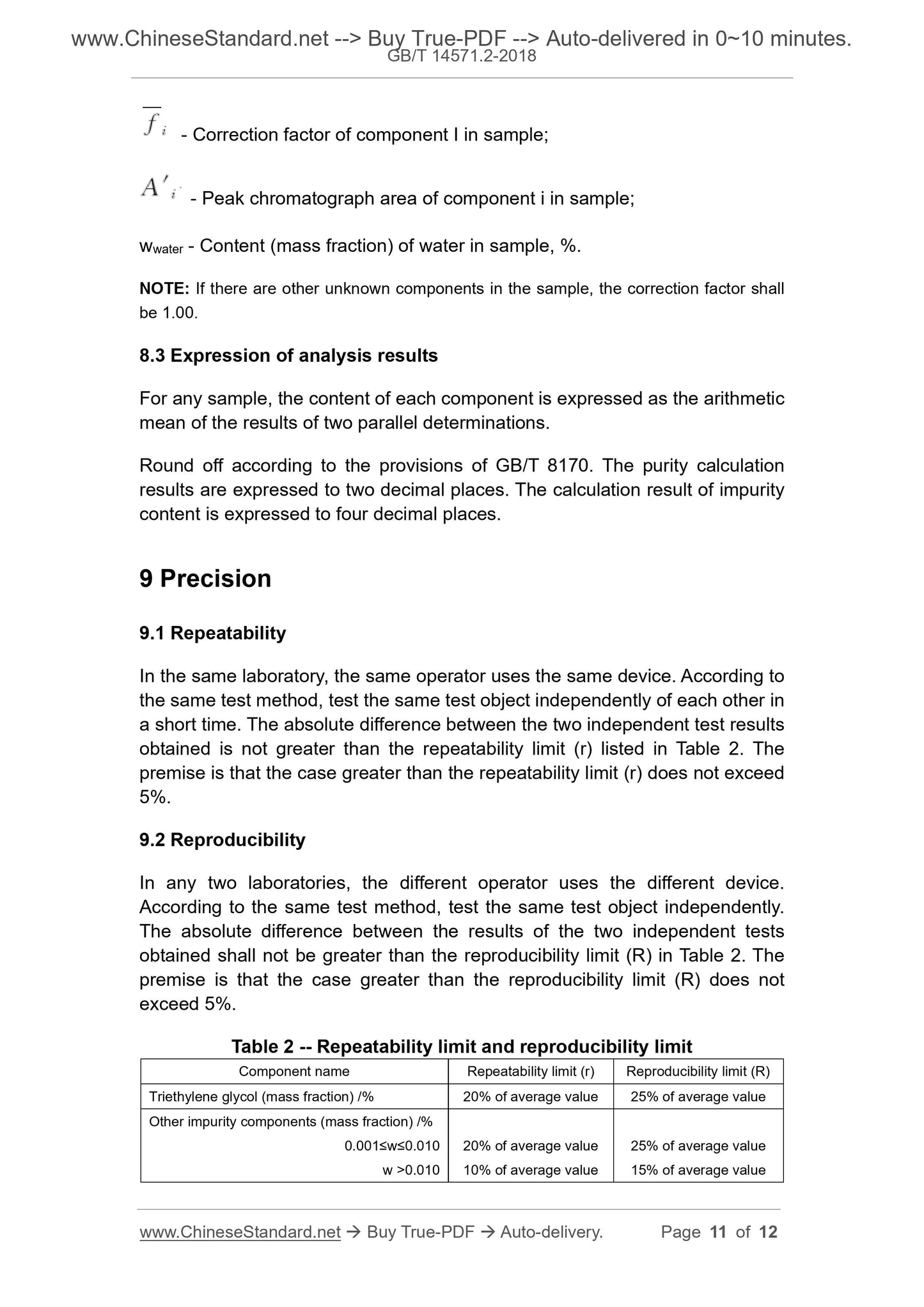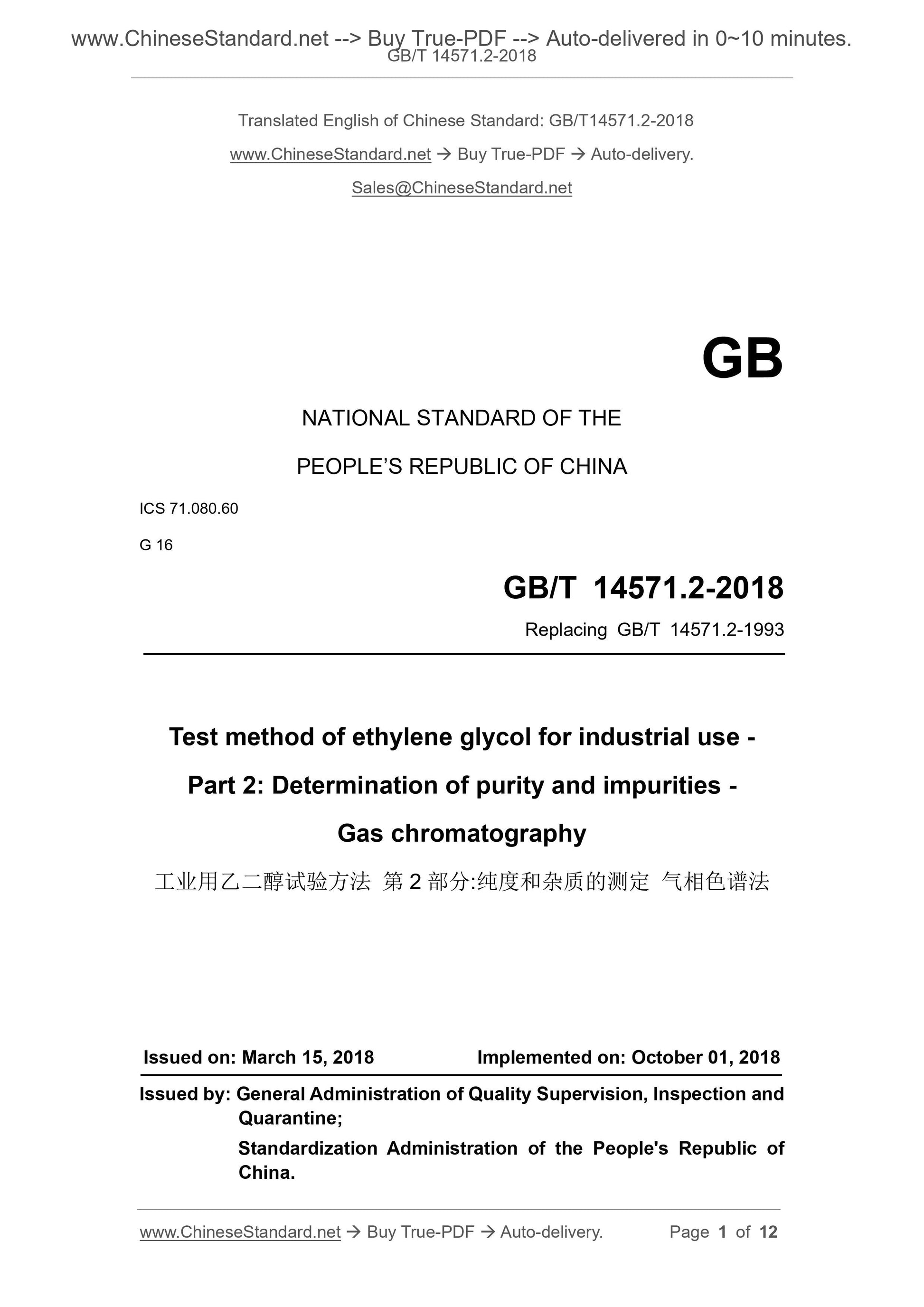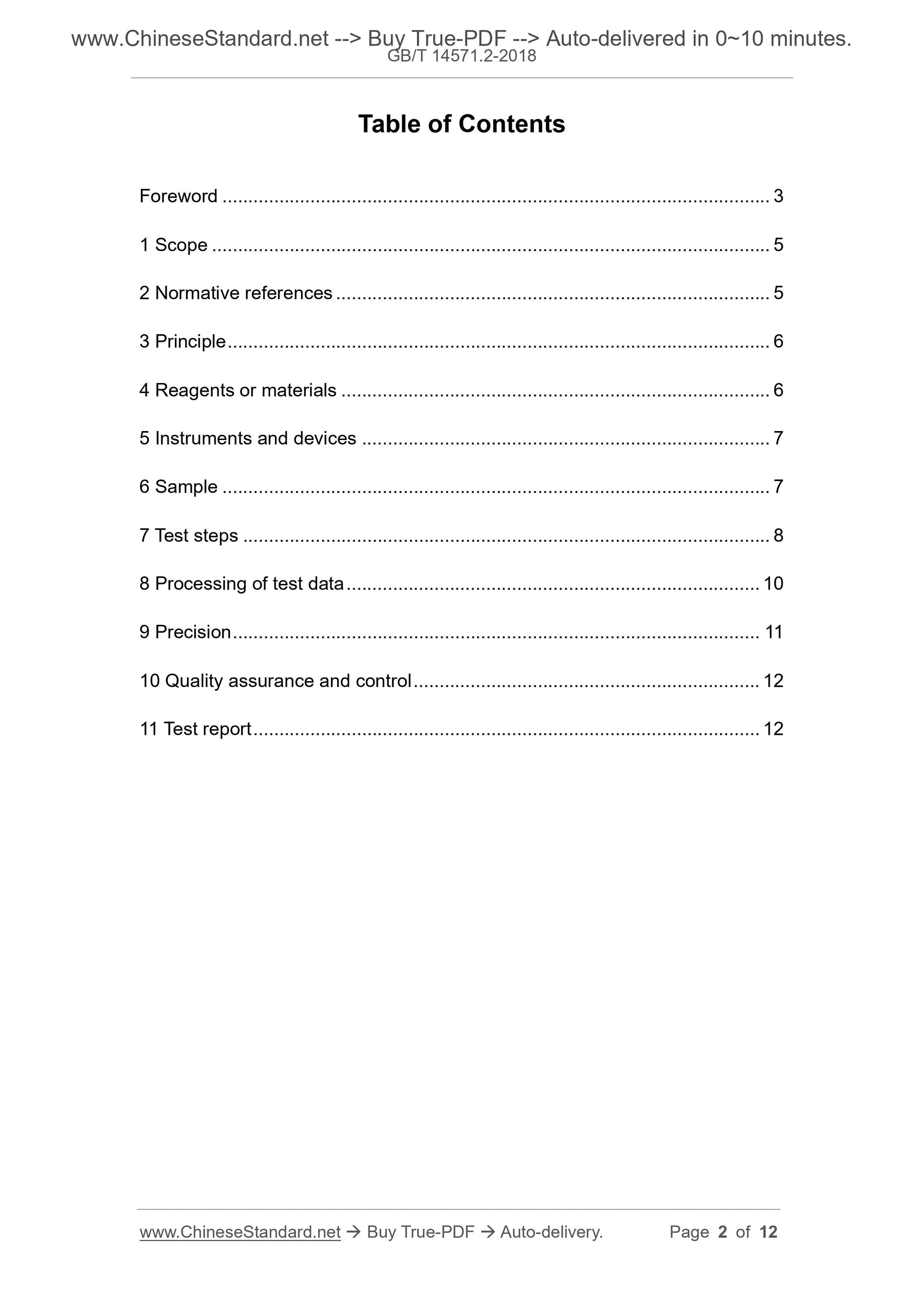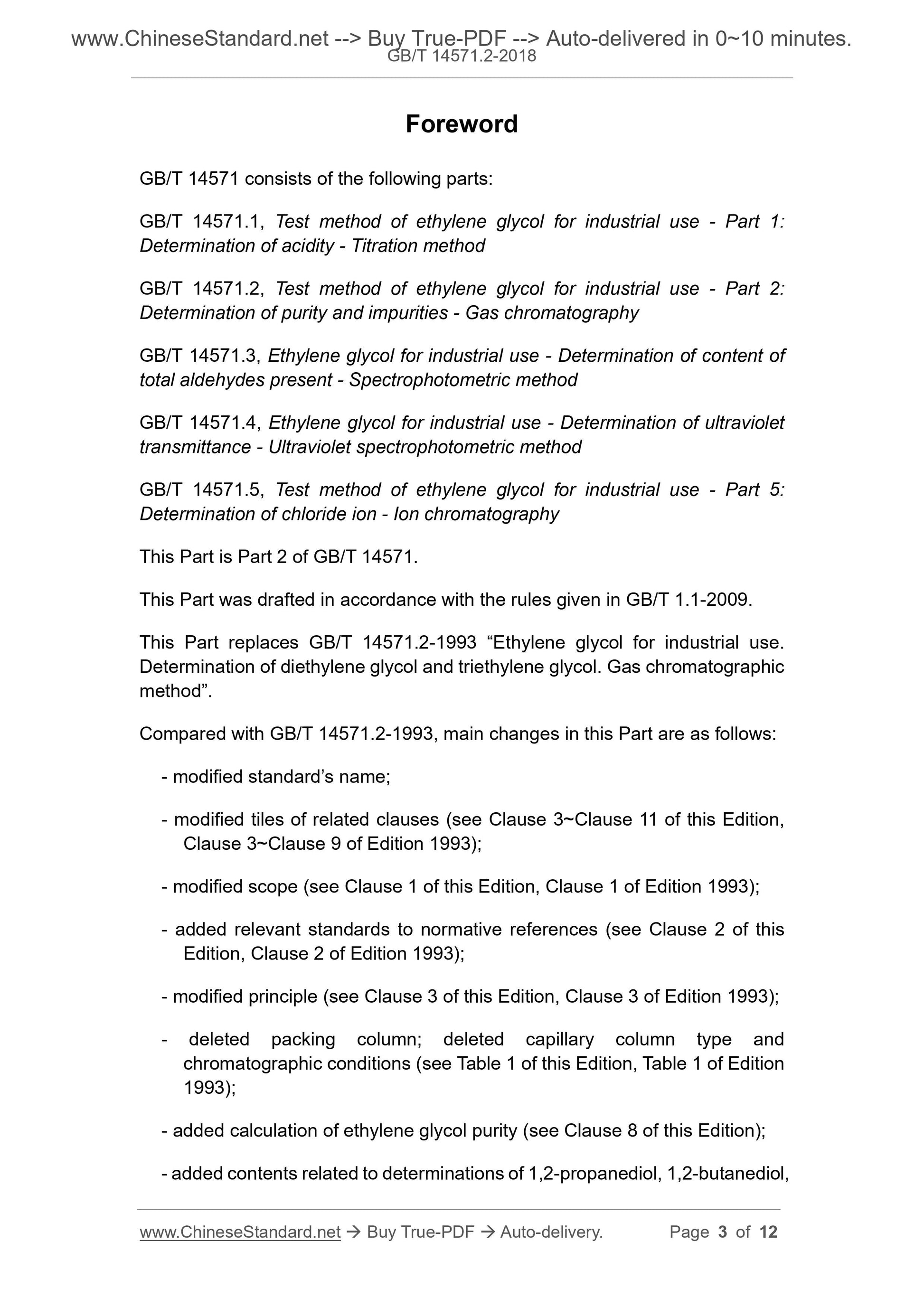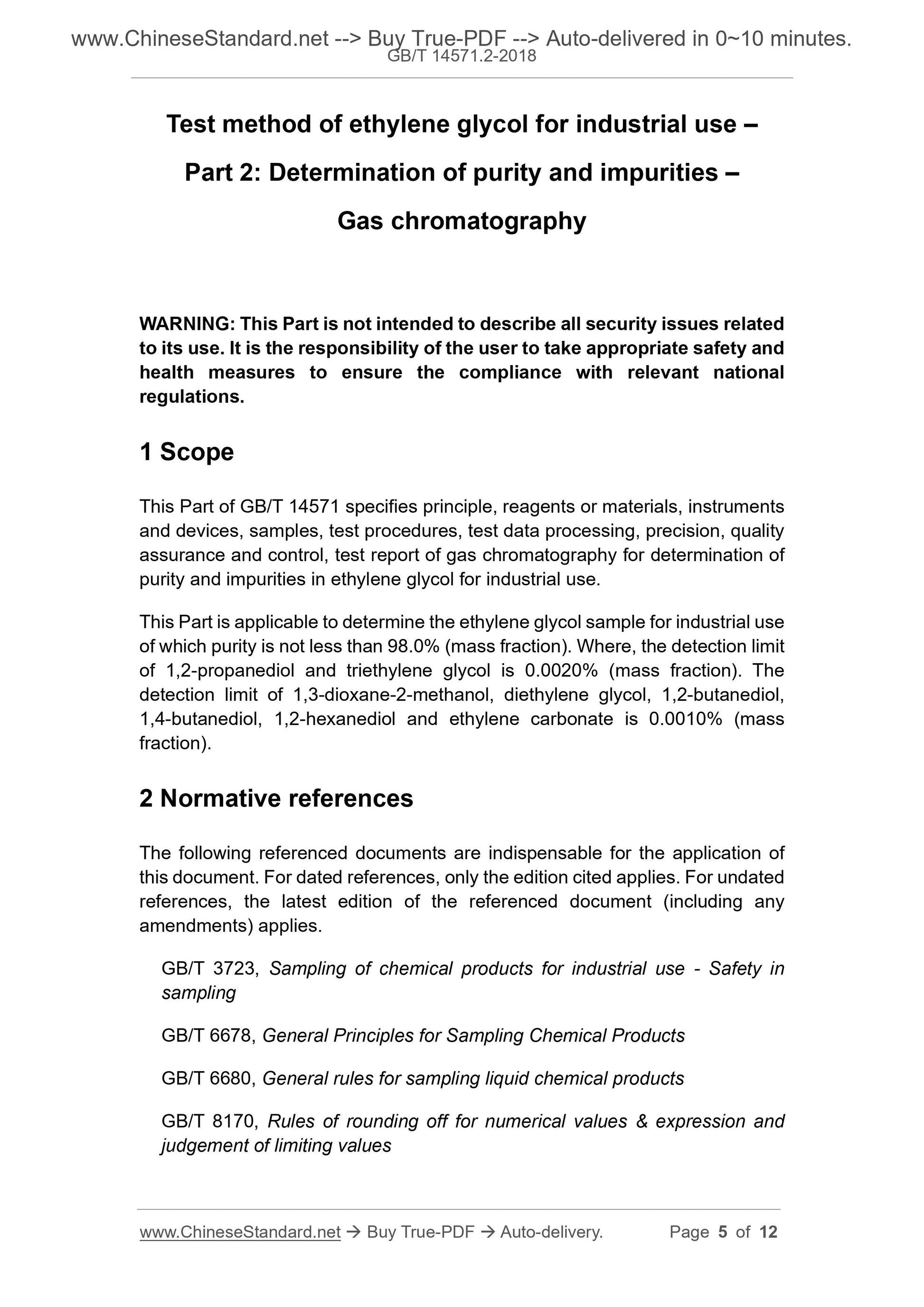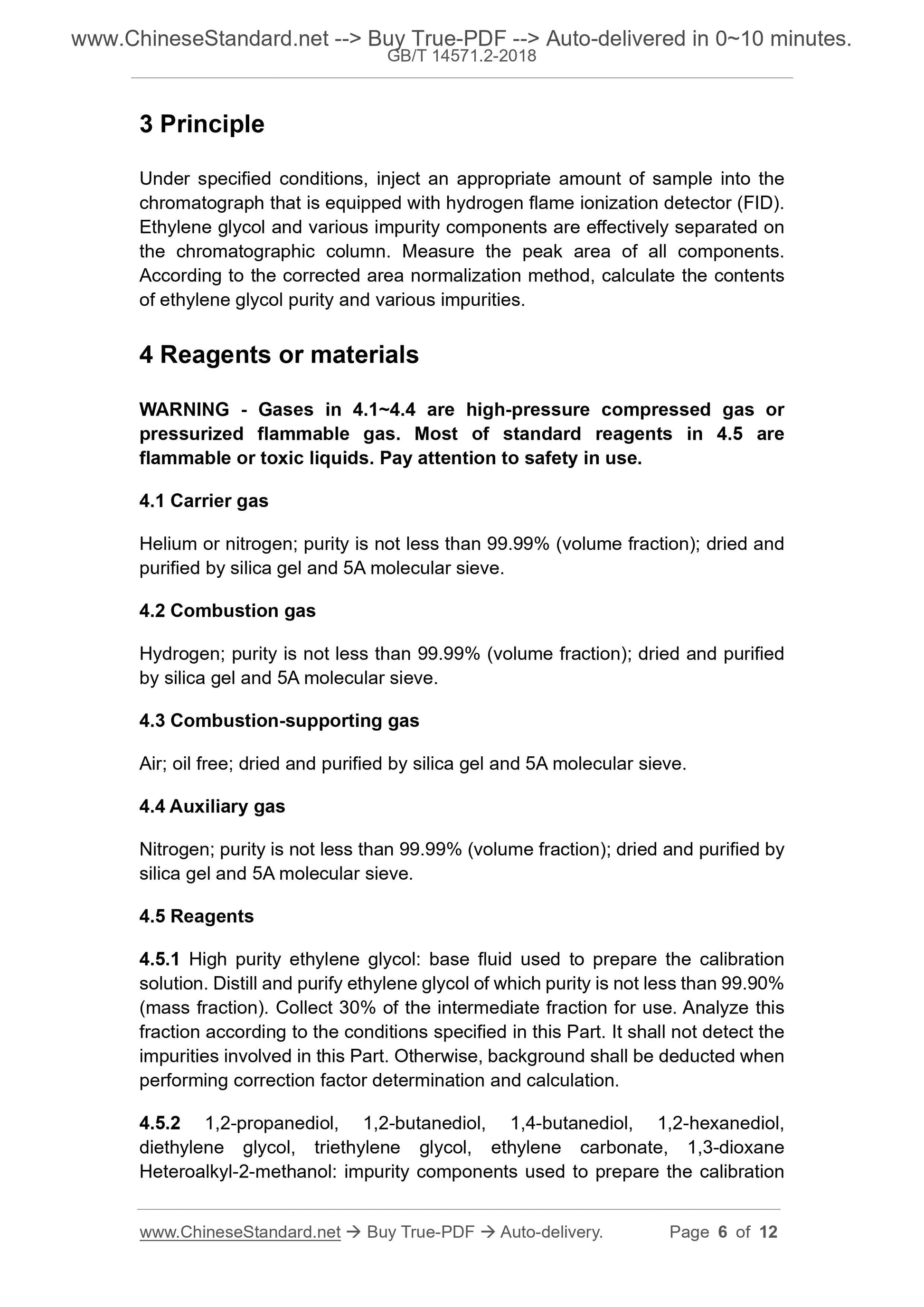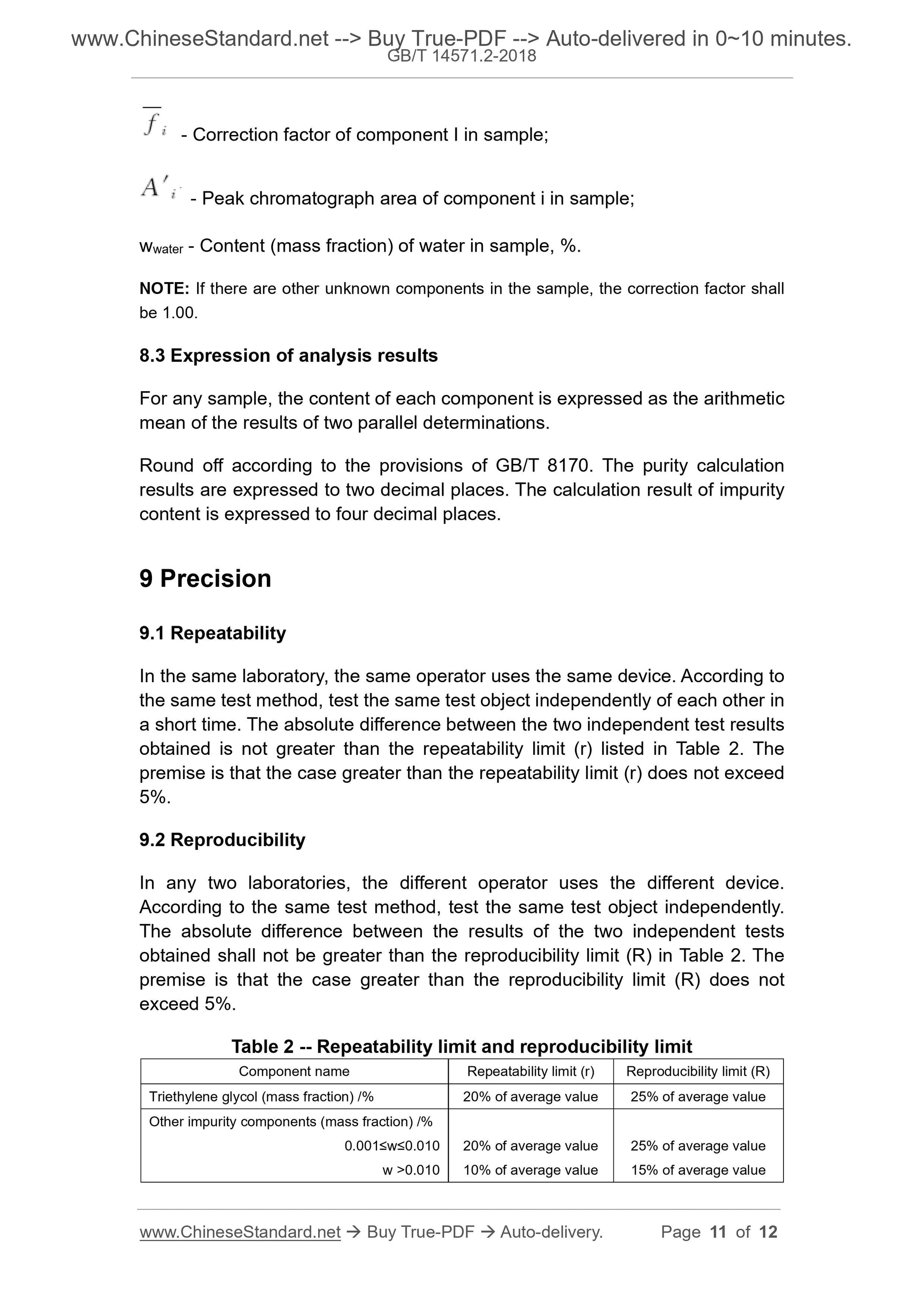1
/
of
6
www.ChineseStandard.us -- Field Test Asia Pte. Ltd.
GB/T 14571.2-2018 English PDF (GB/T14571.2-2018)
GB/T 14571.2-2018 English PDF (GB/T14571.2-2018)
Regular price
$150.00
Regular price
Sale price
$150.00
Unit price
/
per
Shipping calculated at checkout.
Couldn't load pickup availability
GB/T 14571.2-2018: Test method of ethylene glycol for industrial use - Part 2: Determination of purity and impurities - Gas chromatography
Delivery: 9 seconds. Download (& Email) true-PDF + Invoice.
Get Quotation: Click GB/T 14571.2-2018 (Self-service in 1-minute)
Historical versions (Master-website): GB/T 14571.2-2018
Preview True-PDF (Reload/Scroll-down if blank)
GB/T 14571.2-2018
NATIONAL STANDARD OF THE
PEOPLE’S REPUBLIC OF CHINA
ICS 71.080.60
G 16
Replacing GB/T 14571.2-1993
Test method of ethylene glycol for industrial use -
Part 2: Determination of purity and impurities -
Gas chromatography
ISSUED ON: MARCH 15, 2018
IMPLEMENTED ON: OCTOBER 01, 2018
Issued by: General Administration of Quality Supervision, Inspection and
Quarantine;
Standardization Administration of the People's Republic of
China.
Table of Contents
Foreword ... 3
1 Scope ... 5
2 Normative references ... 5
3 Principle ... 6
4 Reagents or materials ... 6
5 Instruments and devices ... 7
6 Sample ... 7
7 Test steps ... 8
8 Processing of test data ... 10
9 Precision ... 11
10 Quality assurance and control ... 12
11 Test report ... 12
Foreword
GB/T 14571 consists of the following parts:
GB/T 14571.1, Test method of ethylene glycol for industrial use - Part 1:
Determination of acidity - Titration method
GB/T 14571.2, Test method of ethylene glycol for industrial use - Part 2:
Determination of purity and impurities - Gas chromatography
GB/T 14571.3, Ethylene glycol for industrial use - Determination of content of
total aldehydes present - Spectrophotometric method
GB/T 14571.4, Ethylene glycol for industrial use - Determination of ultraviolet
transmittance - Ultraviolet spectrophotometric method
GB/T 14571.5, Test method of ethylene glycol for industrial use - Part 5:
Determination of chloride ion - Ion chromatography
This Part is Part 2 of GB/T 14571.
This Part was drafted in accordance with the rules given in GB/T 1.1-2009.
This Part replaces GB/T 14571.2-1993 “Ethylene glycol for industrial use.
Determination of diethylene glycol and triethylene glycol. Gas chromatographic
method”.
Compared with GB/T 14571.2-1993, main changes in this Part are as follows:
- modified standard’s name;
- modified tiles of related clauses (see Clause 3~Clause 11 of this Edition,
Clause 3~Clause 9 of Edition 1993);
- modified scope (see Clause 1 of this Edition, Clause 1 of Edition 1993);
- added relevant standards to normative references (see Clause 2 of this
Edition, Clause 2 of Edition 1993);
- modified principle (see Clause 3 of this Edition, Clause 3 of Edition 1993);
- deleted packing column; deleted capillary column type and
chromatographic conditions (see Table 1 of this Edition, Table 1 of Edition
1993);
- added calculation of ethylene glycol purity (see Clause 8 of this Edition);
- added contents related to determinations of 1,2-propanediol, 1,2-butanediol,
Test method of ethylene glycol for industrial use –
Part 2: Determination of purity and impurities –
Gas chromatography
WARNING: This Part is not intended to describe all security issues related
to its use. It is the responsibility of the user to take appropriate safety and
health measures to ensure the compliance with relevant national
regulations.
1 Scope
This Part of GB/T 14571 specifies principle, reagents or materials, instruments
and devices, samples, test procedures, test data processing, precision, quality
assurance and control, test report of gas chromatography for determination of
purity and impurities in ethylene glycol for industrial use.
This Part is applicable to determine the ethylene glycol sample for industrial use
of which purity is not less than 98.0% (mass fraction). Where, the detection limit
of 1,2-propanediol and triethylene glycol is 0.0020% (mass fraction). The
detection limit of 1,3-dioxane-2-methanol, diethylene glycol, 1,2-butanediol,
1,4-butanediol, 1,2-hexanediol and ethylene carbonate is 0.0010% (mass
fraction).
2 Normative references
The following referenced documents are indispensable for the application of
this document. For dated references, only the edition cited applies. For undated
references, the latest edition of the referenced document (including any
amendments) applies.
GB/T 3723, Sampling of chemical products for industrial use - Safety in
sampling
GB/T 6678, General Principles for Sampling Chemical Products
GB/T 6680, General rules for sampling liquid chemical products
GB/T 8170, Rules of rounding off for numerical values and expression and
judgement of limiting values
3 Principle
Under specified conditions, inject an appropriate amount of sample into the
chromatograph that is equipped with hydrogen flame ionization detector (FID).
Ethylene glycol and various impurity components are effectively separated on
the chromatographic column. Measure the peak area of all components.
According to the corrected area normalization method, calculate the contents
of ethylene glycol purity and various impurities.
4 Reagents or materials
WARNING - Gases in 4.1~4.4 are high-pressure compressed gas or
pressurized flammable gas. Most of standard reagents in 4.5 are
flammable or toxic liquids. Pay attention to safety in use.
4.1 Carrier gas
Helium or nitrogen; purity is not less than 99.99% (volume fraction); dried and
purified by silica gel and 5A molecular sieve.
4.2 Combustion gas
Hydrogen; purity is not less than 99.99% (volume fraction); dried and purified
by silica gel and 5A molecular sieve.
4.3 Combustion-supporting gas
Air; oil free; dried and purified by silica gel and 5A molecular sieve.
4.4 Auxiliary gas
Nitrogen; purity is not less than 99.99% (volume fraction); dried and purified by
silica gel and 5A molecular sieve.
4.5 Reagents
4.5.1 High purity ethylene glycol: base fluid used to prepare the calibration
solution. Distill and purify ethylene glycol of which purity is not less than 99.90%
(mass fraction). Collect 30% of the intermediate fraction for use. Analyze this
fraction according to the conditions specified in this Part. It shall not detect the
impurities involved in this Part. Otherwise, background shall be deducted when
performing correction factor determination and calculation.
4.5.2 1,2-propanediol, 1,2-butanediol, 1,4-butanediol, 1,2-hexanediol,
diethylene glycol, triethylene glycol, ethylene carbonate, 1,3-dioxane
Heteroalkyl-2-methanol: impurity components used to prepare the calibration
- Correction factor of component I in sample;
- Peak chromatograph area of component i in sample;
wwater - Content (mass fraction) of water in sample, %.
NOTE: If there are other unknown components in the sample, the correction factor shall
be 1.00.
8.3 Expression of analysis results
For any sample, the content of each component is expressed as the arithmetic
mean of the results of two parallel determinations.
Round off according to the provisions of GB/T 8170. The purity calculation
results are expressed to two decimal places. The calculation result of impurity
content is expressed to four decimal places.
9 Precision
9.1 Repeatability
In the same laboratory, the same operator uses the same device. According to
the same test method, test the same test object independently of each other in
a short time. The absolute difference between the two independent test results
obtained is not greater than the repeatability limit (r) listed in Table 2. The
premise is that the case greater than the repeatability limit (r) does not exceed
5%.
9.2 Reproducibility
In any two laboratories, the different operator uses the different device.
According to the same test method, test the same test object independently.
The absolute difference between the results of the two independent tests
obtained shall not be greater than the reproducibility limit (R) in Table 2. The
premise is that the case greater than the reproducibility limit (R) does not
exceed 5%.
Table 2 -- Repeatability limit and reproducibility limit
Component name Repeatability limit (r) Reproducibility limit (R)
Triethylene glycol (mass fraction) /% 20% of average value 25% of average value
Other impurity components (mass fraction) /%
0.001≤w≤0.010 20% of average value 25% of average value
w >0.010 10% of average value 15% of average value
GB/T 14571.2-2018
NATIONAL STANDARD OF THE
PEOPLE’S REPUBLIC OF CHINA
ICS 71.080.60
G 16
Replacing GB/T 14571.2-1993
Test method of ethylene glycol for industrial use -
Part 2: Determination of purity and impurities -
Gas chromatography
ISSUED ON: MARCH 15, 2018
IMPLEMENTED ON: OCTOBER 01, 2018
Issued by: General Administration of Quality Supervision, Inspection and
Quarantine;
Standardization Administration of the People's Republic of
China.
Table of Contents
Foreword ... 3
1 Scope ... 5
2 Normative references ... 5
3 Principle ... 6
4 Reagents or materials ... 6
5 Instruments and devices ... 7
6 Sample ... 7
7 Test steps ... 8
8 Processing of test data ... 10
9 Precision ... 11
10 Quality assurance and control ... 12
11 Test report ... 12
Foreword
GB/T 14571 consists of the following parts:
GB/T 14571.1, Test method of ethylene glycol for industrial use - Part 1:
Determination of acidity - Titration method
GB/T 14571.2, Test method of ethylene glycol for industrial use - Part 2:
Determination of purity and impurities - Gas chromatography
GB/T 14571.3, Ethylene glycol for industrial use - Determination of content of
total aldehydes present - Spectrophotometric method
GB/T 14571.4, Ethylene glycol for industrial use - Determination of ultraviolet
transmittance - Ultraviolet spectrophotometric method
GB/T 14571.5, Test method of ethylene glycol for industrial use - Part 5:
Determination of chloride ion - Ion chromatography
This Part is Part 2 of GB/T 14571.
This Part was drafted in accordance with the rules given in GB/T 1.1-2009.
This Part replaces GB/T 14571.2-1993 “Ethylene glycol for industrial use.
Determination of diethylene glycol and triethylene glycol. Gas chromatographic
method”.
Compared with GB/T 14571.2-1993, main changes in this Part are as follows:
- modified standard’s name;
- modified tiles of related clauses (see Clause 3~Clause 11 of this Edition,
Clause 3~Clause 9 of Edition 1993);
- modified scope (see Clause 1 of this Edition, Clause 1 of Edition 1993);
- added relevant standards to normative references (see Clause 2 of this
Edition, Clause 2 of Edition 1993);
- modified principle (see Clause 3 of this Edition, Clause 3 of Edition 1993);
- deleted packing column; deleted capillary column type and
chromatographic conditions (see Table 1 of this Edition, Table 1 of Edition
1993);
- added calculation of ethylene glycol purity (see Clause 8 of this Edition);
- added contents related to determinations of 1,2-propanediol, 1,2-butanediol,
Test method of ethylene glycol for industrial use –
Part 2: Determination of purity and impurities –
Gas chromatography
WARNING: This Part is not intended to describe all security issues related
to its use. It is the responsibility of the user to take appropriate safety and
health measures to ensure the compliance with relevant national
regulations.
1 Scope
This Part of GB/T 14571 specifies principle, reagents or materials, instruments
and devices, samples, test procedures, test data processing, precision, quality
assurance and control, test report of gas chromatography for determination of
purity and impurities in ethylene glycol for industrial use.
This Part is applicable to determine the ethylene glycol sample for industrial use
of which purity is not less than 98.0% (mass fraction). Where, the detection limit
of 1,2-propanediol and triethylene glycol is 0.0020% (mass fraction). The
detection limit of 1,3-dioxane-2-methanol, diethylene glycol, 1,2-butanediol,
1,4-butanediol, 1,2-hexanediol and ethylene carbonate is 0.0010% (mass
fraction).
2 Normative references
The following referenced documents are indispensable for the application of
this document. For dated references, only the edition cited applies. For undated
references, the latest edition of the referenced document (including any
amendments) applies.
GB/T 3723, Sampling of chemical products for industrial use - Safety in
sampling
GB/T 6678, General Principles for Sampling Chemical Products
GB/T 6680, General rules for sampling liquid chemical products
GB/T 8170, Rules of rounding off for numerical values and expression and
judgement of limiting values
3 Principle
Under specified conditions, inject an appropriate amount of sample into the
chromatograph that is equipped with hydrogen flame ionization detector (FID).
Ethylene glycol and various impurity components are effectively separated on
the chromatographic column. Measure the peak area of all components.
According to the corrected area normalization method, calculate the contents
of ethylene glycol purity and various impurities.
4 Reagents or materials
WARNING - Gases in 4.1~4.4 are high-pressure compressed gas or
pressurized flammable gas. Most of standard reagents in 4.5 are
flammable or toxic liquids. Pay attention to safety in use.
4.1 Carrier gas
Helium or nitrogen; purity is not less than 99.99% (volume fraction); dried and
purified by silica gel and 5A molecular sieve.
4.2 Combustion gas
Hydrogen; purity is not less than 99.99% (volume fraction); dried and purified
by silica gel and 5A molecular sieve.
4.3 Combustion-supporting gas
Air; oil free; dried and purified by silica gel and 5A molecular sieve.
4.4 Auxiliary gas
Nitrogen; purity is not less than 99.99% (volume fraction); dried and purified by
silica gel and 5A molecular sieve.
4.5 Reagents
4.5.1 High purity ethylene glycol: base fluid used to prepare the calibration
solution. Distill and purify ethylene glycol of which purity is not less than 99.90%
(mass fraction). Collect 30% of the intermediate fraction for use. Analyze this
fraction according to the conditions specified in this Part. It shall not detect the
impurities involved in this Part. Otherwise, background shall be deducted when
performing correction factor determination and calculation.
4.5.2 1,2-propanediol, 1,2-butanediol, 1,4-butane...
Delivery: 9 seconds. Download (& Email) true-PDF + Invoice.
Get Quotation: Click GB/T 14571.2-2018 (Self-service in 1-minute)
Historical versions (Master-website): GB/T 14571.2-2018
Preview True-PDF (Reload/Scroll-down if blank)
GB/T 14571.2-2018
NATIONAL STANDARD OF THE
PEOPLE’S REPUBLIC OF CHINA
ICS 71.080.60
G 16
Replacing GB/T 14571.2-1993
Test method of ethylene glycol for industrial use -
Part 2: Determination of purity and impurities -
Gas chromatography
ISSUED ON: MARCH 15, 2018
IMPLEMENTED ON: OCTOBER 01, 2018
Issued by: General Administration of Quality Supervision, Inspection and
Quarantine;
Standardization Administration of the People's Republic of
China.
Table of Contents
Foreword ... 3
1 Scope ... 5
2 Normative references ... 5
3 Principle ... 6
4 Reagents or materials ... 6
5 Instruments and devices ... 7
6 Sample ... 7
7 Test steps ... 8
8 Processing of test data ... 10
9 Precision ... 11
10 Quality assurance and control ... 12
11 Test report ... 12
Foreword
GB/T 14571 consists of the following parts:
GB/T 14571.1, Test method of ethylene glycol for industrial use - Part 1:
Determination of acidity - Titration method
GB/T 14571.2, Test method of ethylene glycol for industrial use - Part 2:
Determination of purity and impurities - Gas chromatography
GB/T 14571.3, Ethylene glycol for industrial use - Determination of content of
total aldehydes present - Spectrophotometric method
GB/T 14571.4, Ethylene glycol for industrial use - Determination of ultraviolet
transmittance - Ultraviolet spectrophotometric method
GB/T 14571.5, Test method of ethylene glycol for industrial use - Part 5:
Determination of chloride ion - Ion chromatography
This Part is Part 2 of GB/T 14571.
This Part was drafted in accordance with the rules given in GB/T 1.1-2009.
This Part replaces GB/T 14571.2-1993 “Ethylene glycol for industrial use.
Determination of diethylene glycol and triethylene glycol. Gas chromatographic
method”.
Compared with GB/T 14571.2-1993, main changes in this Part are as follows:
- modified standard’s name;
- modified tiles of related clauses (see Clause 3~Clause 11 of this Edition,
Clause 3~Clause 9 of Edition 1993);
- modified scope (see Clause 1 of this Edition, Clause 1 of Edition 1993);
- added relevant standards to normative references (see Clause 2 of this
Edition, Clause 2 of Edition 1993);
- modified principle (see Clause 3 of this Edition, Clause 3 of Edition 1993);
- deleted packing column; deleted capillary column type and
chromatographic conditions (see Table 1 of this Edition, Table 1 of Edition
1993);
- added calculation of ethylene glycol purity (see Clause 8 of this Edition);
- added contents related to determinations of 1,2-propanediol, 1,2-butanediol,
Test method of ethylene glycol for industrial use –
Part 2: Determination of purity and impurities –
Gas chromatography
WARNING: This Part is not intended to describe all security issues related
to its use. It is the responsibility of the user to take appropriate safety and
health measures to ensure the compliance with relevant national
regulations.
1 Scope
This Part of GB/T 14571 specifies principle, reagents or materials, instruments
and devices, samples, test procedures, test data processing, precision, quality
assurance and control, test report of gas chromatography for determination of
purity and impurities in ethylene glycol for industrial use.
This Part is applicable to determine the ethylene glycol sample for industrial use
of which purity is not less than 98.0% (mass fraction). Where, the detection limit
of 1,2-propanediol and triethylene glycol is 0.0020% (mass fraction). The
detection limit of 1,3-dioxane-2-methanol, diethylene glycol, 1,2-butanediol,
1,4-butanediol, 1,2-hexanediol and ethylene carbonate is 0.0010% (mass
fraction).
2 Normative references
The following referenced documents are indispensable for the application of
this document. For dated references, only the edition cited applies. For undated
references, the latest edition of the referenced document (including any
amendments) applies.
GB/T 3723, Sampling of chemical products for industrial use - Safety in
sampling
GB/T 6678, General Principles for Sampling Chemical Products
GB/T 6680, General rules for sampling liquid chemical products
GB/T 8170, Rules of rounding off for numerical values and expression and
judgement of limiting values
3 Principle
Under specified conditions, inject an appropriate amount of sample into the
chromatograph that is equipped with hydrogen flame ionization detector (FID).
Ethylene glycol and various impurity components are effectively separated on
the chromatographic column. Measure the peak area of all components.
According to the corrected area normalization method, calculate the contents
of ethylene glycol purity and various impurities.
4 Reagents or materials
WARNING - Gases in 4.1~4.4 are high-pressure compressed gas or
pressurized flammable gas. Most of standard reagents in 4.5 are
flammable or toxic liquids. Pay attention to safety in use.
4.1 Carrier gas
Helium or nitrogen; purity is not less than 99.99% (volume fraction); dried and
purified by silica gel and 5A molecular sieve.
4.2 Combustion gas
Hydrogen; purity is not less than 99.99% (volume fraction); dried and purified
by silica gel and 5A molecular sieve.
4.3 Combustion-supporting gas
Air; oil free; dried and purified by silica gel and 5A molecular sieve.
4.4 Auxiliary gas
Nitrogen; purity is not less than 99.99% (volume fraction); dried and purified by
silica gel and 5A molecular sieve.
4.5 Reagents
4.5.1 High purity ethylene glycol: base fluid used to prepare the calibration
solution. Distill and purify ethylene glycol of which purity is not less than 99.90%
(mass fraction). Collect 30% of the intermediate fraction for use. Analyze this
fraction according to the conditions specified in this Part. It shall not detect the
impurities involved in this Part. Otherwise, background shall be deducted when
performing correction factor determination and calculation.
4.5.2 1,2-propanediol, 1,2-butanediol, 1,4-butanediol, 1,2-hexanediol,
diethylene glycol, triethylene glycol, ethylene carbonate, 1,3-dioxane
Heteroalkyl-2-methanol: impurity components used to prepare the calibration
- Correction factor of component I in sample;
- Peak chromatograph area of component i in sample;
wwater - Content (mass fraction) of water in sample, %.
NOTE: If there are other unknown components in the sample, the correction factor shall
be 1.00.
8.3 Expression of analysis results
For any sample, the content of each component is expressed as the arithmetic
mean of the results of two parallel determinations.
Round off according to the provisions of GB/T 8170. The purity calculation
results are expressed to two decimal places. The calculation result of impurity
content is expressed to four decimal places.
9 Precision
9.1 Repeatability
In the same laboratory, the same operator uses the same device. According to
the same test method, test the same test object independently of each other in
a short time. The absolute difference between the two independent test results
obtained is not greater than the repeatability limit (r) listed in Table 2. The
premise is that the case greater than the repeatability limit (r) does not exceed
5%.
9.2 Reproducibility
In any two laboratories, the different operator uses the different device.
According to the same test method, test the same test object independently.
The absolute difference between the results of the two independent tests
obtained shall not be greater than the reproducibility limit (R) in Table 2. The
premise is that the case greater than the reproducibility limit (R) does not
exceed 5%.
Table 2 -- Repeatability limit and reproducibility limit
Component name Repeatability limit (r) Reproducibility limit (R)
Triethylene glycol (mass fraction) /% 20% of average value 25% of average value
Other impurity components (mass fraction) /%
0.001≤w≤0.010 20% of average value 25% of average value
w >0.010 10% of average value 15% of average value
GB/T 14571.2-2018
NATIONAL STANDARD OF THE
PEOPLE’S REPUBLIC OF CHINA
ICS 71.080.60
G 16
Replacing GB/T 14571.2-1993
Test method of ethylene glycol for industrial use -
Part 2: Determination of purity and impurities -
Gas chromatography
ISSUED ON: MARCH 15, 2018
IMPLEMENTED ON: OCTOBER 01, 2018
Issued by: General Administration of Quality Supervision, Inspection and
Quarantine;
Standardization Administration of the People's Republic of
China.
Table of Contents
Foreword ... 3
1 Scope ... 5
2 Normative references ... 5
3 Principle ... 6
4 Reagents or materials ... 6
5 Instruments and devices ... 7
6 Sample ... 7
7 Test steps ... 8
8 Processing of test data ... 10
9 Precision ... 11
10 Quality assurance and control ... 12
11 Test report ... 12
Foreword
GB/T 14571 consists of the following parts:
GB/T 14571.1, Test method of ethylene glycol for industrial use - Part 1:
Determination of acidity - Titration method
GB/T 14571.2, Test method of ethylene glycol for industrial use - Part 2:
Determination of purity and impurities - Gas chromatography
GB/T 14571.3, Ethylene glycol for industrial use - Determination of content of
total aldehydes present - Spectrophotometric method
GB/T 14571.4, Ethylene glycol for industrial use - Determination of ultraviolet
transmittance - Ultraviolet spectrophotometric method
GB/T 14571.5, Test method of ethylene glycol for industrial use - Part 5:
Determination of chloride ion - Ion chromatography
This Part is Part 2 of GB/T 14571.
This Part was drafted in accordance with the rules given in GB/T 1.1-2009.
This Part replaces GB/T 14571.2-1993 “Ethylene glycol for industrial use.
Determination of diethylene glycol and triethylene glycol. Gas chromatographic
method”.
Compared with GB/T 14571.2-1993, main changes in this Part are as follows:
- modified standard’s name;
- modified tiles of related clauses (see Clause 3~Clause 11 of this Edition,
Clause 3~Clause 9 of Edition 1993);
- modified scope (see Clause 1 of this Edition, Clause 1 of Edition 1993);
- added relevant standards to normative references (see Clause 2 of this
Edition, Clause 2 of Edition 1993);
- modified principle (see Clause 3 of this Edition, Clause 3 of Edition 1993);
- deleted packing column; deleted capillary column type and
chromatographic conditions (see Table 1 of this Edition, Table 1 of Edition
1993);
- added calculation of ethylene glycol purity (see Clause 8 of this Edition);
- added contents related to determinations of 1,2-propanediol, 1,2-butanediol,
Test method of ethylene glycol for industrial use –
Part 2: Determination of purity and impurities –
Gas chromatography
WARNING: This Part is not intended to describe all security issues related
to its use. It is the responsibility of the user to take appropriate safety and
health measures to ensure the compliance with relevant national
regulations.
1 Scope
This Part of GB/T 14571 specifies principle, reagents or materials, instruments
and devices, samples, test procedures, test data processing, precision, quality
assurance and control, test report of gas chromatography for determination of
purity and impurities in ethylene glycol for industrial use.
This Part is applicable to determine the ethylene glycol sample for industrial use
of which purity is not less than 98.0% (mass fraction). Where, the detection limit
of 1,2-propanediol and triethylene glycol is 0.0020% (mass fraction). The
detection limit of 1,3-dioxane-2-methanol, diethylene glycol, 1,2-butanediol,
1,4-butanediol, 1,2-hexanediol and ethylene carbonate is 0.0010% (mass
fraction).
2 Normative references
The following referenced documents are indispensable for the application of
this document. For dated references, only the edition cited applies. For undated
references, the latest edition of the referenced document (including any
amendments) applies.
GB/T 3723, Sampling of chemical products for industrial use - Safety in
sampling
GB/T 6678, General Principles for Sampling Chemical Products
GB/T 6680, General rules for sampling liquid chemical products
GB/T 8170, Rules of rounding off for numerical values and expression and
judgement of limiting values
3 Principle
Under specified conditions, inject an appropriate amount of sample into the
chromatograph that is equipped with hydrogen flame ionization detector (FID).
Ethylene glycol and various impurity components are effectively separated on
the chromatographic column. Measure the peak area of all components.
According to the corrected area normalization method, calculate the contents
of ethylene glycol purity and various impurities.
4 Reagents or materials
WARNING - Gases in 4.1~4.4 are high-pressure compressed gas or
pressurized flammable gas. Most of standard reagents in 4.5 are
flammable or toxic liquids. Pay attention to safety in use.
4.1 Carrier gas
Helium or nitrogen; purity is not less than 99.99% (volume fraction); dried and
purified by silica gel and 5A molecular sieve.
4.2 Combustion gas
Hydrogen; purity is not less than 99.99% (volume fraction); dried and purified
by silica gel and 5A molecular sieve.
4.3 Combustion-supporting gas
Air; oil free; dried and purified by silica gel and 5A molecular sieve.
4.4 Auxiliary gas
Nitrogen; purity is not less than 99.99% (volume fraction); dried and purified by
silica gel and 5A molecular sieve.
4.5 Reagents
4.5.1 High purity ethylene glycol: base fluid used to prepare the calibration
solution. Distill and purify ethylene glycol of which purity is not less than 99.90%
(mass fraction). Collect 30% of the intermediate fraction for use. Analyze this
fraction according to the conditions specified in this Part. It shall not detect the
impurities involved in this Part. Otherwise, background shall be deducted when
performing correction factor determination and calculation.
4.5.2 1,2-propanediol, 1,2-butanediol, 1,4-butane...
Share
